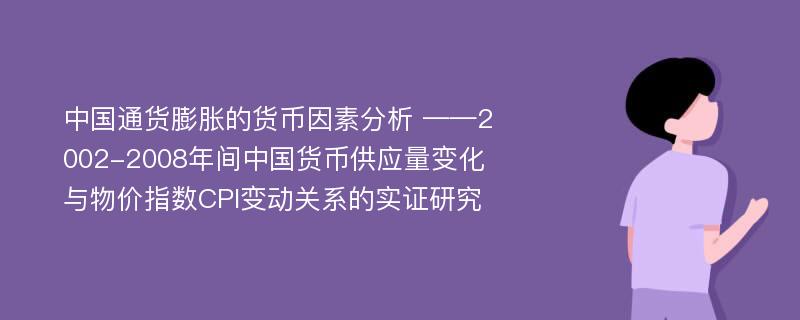
论文摘要
本文以研究中国通货膨胀的货币因素作为出发点,以探讨货币供应量与通货膨胀之间的因果关系为目的,通过具体实证分析2002年1月至2008年4月期间的通货膨胀与各层次货币供应量的相互关系得出M1与通货膨胀存在单向的格兰杰因果关系的结论。在文章结构安排上首先就通货膨胀的定义、度量指标、主要理论及一般的应对策略做了系统性的描述,同时就与货币供应有关的概念如基础货币、货币乘数,具体的划分和它的外生性及内生性做了介绍。然后结合具体数据来概括2002-2008年期间我国货币供应量和物价指数其中包括基础货币,货币乘数、货币量M0、M1和M2的具体情况,以及这段时间内衡量通货膨胀的CPI的变化及一些主要的特点。在以上理论描述和实际数据的结合的基础上,接着用实证分析的手段来确认M0,M1和M2各自同比增长率与CPI同比增长率的关系。得出的结论是在2002年1月到2008年4月期间M0、M2与通货膨胀之间的同比增长率不存在格兰杰因果关系,而M1与通货膨胀的同比增长率则存在格兰杰因果关系。之所以M1同比增长率与通货膨胀同比增长率存在这种因果关系,笔者认为M1是流动性最强的金融资产同时又可以看作是处于流动中的货币量,与物价水平的变化关系最密切。而M0是流通中的现金,虽然流动性很强,但在现今比较发达的支付体系中只是流通货币量的一部分,与物价直接关系不大。而M2不存在这种因果关系,可能因为它作为货币总量的概念,虽然对通货膨胀的长期影响是必然存在的,但流动性相对较低对价格水平的直接作用在这六年多的时间内不是很明显。同时在2002年1月到2008年4月期间货币供应M1增长对通货膨胀变动单向性表明它对于通货膨胀来讲是具有外生性的。但是由于对中国相关研究表明,相对于经济总量的增长,货币供应量是具有内生性特性的,经济产出增长必然伴随着货币的增长。这种相对于通货膨胀的外生性和对产出的内生性特点,使得货币供应的控制本身成为一件非常复杂的事情,在协调促进经济增长和保持币值稳定双目标的货币政策最终目标上可能存在内在的矛盾性。
论文目录
相关论文文献
- [1].Consumer inflation to slow in 2020[J]. China Rare Earth Information 2020(02)
- [2].Constraints on brane inflation after Planck 2015: Impacts of the latest local measurement of the Hubble constant[J]. Science China(Physics,Mechanics & Astronomy) 2019(03)
- [3].The observational constraint on constant-roll inflation[J]. Science China(Physics,Mechanics & Astronomy) 2018(07)
- [4].Higher order corrections to asymptotic-de Sitter inflation[J]. Chinese Physics C 2017(08)
- [5].ECONOMY[J]. Beijing Review 2016(51)
- [6].What Causes China's High Inflation? A Threshold Structural Vector Autoregression Analysis[J]. China & World Economy 2013(06)
- [7].Higher Than Expected[J]. Beijing Review 2011(04)
- [8].Bearing Characteristics of Flexible Inflatable Film Aerospace Structure[J]. 上海航天(中英文) 2020(S1)
- [9].Anisotropic inflation with general potentials[J]. Science China(Physics,Mechanics & Astronomy) 2016(04)
- [10].Inflation Targeting and Inflation Persistence[J]. Economic and Political Studies 2015(01)
- [11].Evidence on the Effects of Money Growth on Inflation with Regime Switching[J]. China & World Economy 2011(06)
- [12].Inflation and Economic Growth in China:An Empirical Analysis[J]. China & World Economy 2011(05)
- [13].World Inflation Influences Chinese Economy[J]. Beijing Review 2008(33)
- [14].Study of parachute inflation process using fluid–structure interaction method[J]. Chinese Journal of Aeronautics 2014(02)
- [15].Study of velocity effects on parachute inflation performance based on fluid-structure interaction method[J]. Applied Mathematics and Mechanics(English Edition) 2014(09)
- [16].China Can Endure Inflation Up to 6 Percent[J]. 饲料工业 2011(13)
- [17].China's economic growth and the inflation cycles since reform and opening to the outside world[J]. China Economist 2009(05)
- [18].A gigaparsec-scale local void and the Hubble tension[J]. Science China(Physics,Mechanics & Astronomy) 2020(09)
- [19].Why is Inflation in China a Monetary Phenomenon?[J]. China & World Economy 2011(03)
- [20].THE MOTOR REVS ON[J]. Beijing Review 2011(29)
- [21].New Inflation Factors Looming,Anti-inflation Remains China's No.1 Task[J]. China's Foreign Trade 2011(15)
- [22].China to curb “structural price rise” to “obvious inflation”[J]. China Textile 2008(02)
- [23].Quadratic, Higgs and hilltop potentials in Palatini gravity[J]. Communications in Theoretical Physics 2020(08)
- [24].Business The Econometer[J]. China & Africa 2014(04)
- [25].MARKET WATCH[J]. Beijing Review 2012(10)
- [26].A Dead Cat Bounces[J]. China's Foreign Trade 2012(03)
- [27].Inflation Uncertainty and Monetary Policy in China[J]. China & World Economy 2010(03)
- [28].Does China have Inflationary Effects on the USA and Japan?[J]. China & World Economy 2008(01)
- [29].HOW CAN WE DEAL WITH GLOBAL INFLATION[J]. 华商 2008(15)
- [30].Inflation model selection revisited after a 1.91% measurement of the Hubble constant[J]. Science China(Physics,Mechanics & Astronomy) 2020(09)
